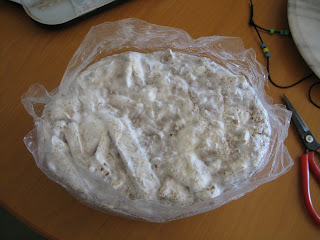 |
| Note the worn leaves being replaced by dark green ones. |
Well, spring is upon us again, and it is time to plant the spring garden. For those of you who live back east, just follow the directions on the seed package: “As soon as the soil can be worked.” Quite simply, that means that once the snow has melted, the ground has thawed out and the extra moisture from the snow has drained off, you can plant. Working in muddy ground destroys the structure of the soil and should be avoided.
I, however, live in the mountains of Arizona. I garden in Zone 7, so I still have distinct winters. Before living here, I lived in Boulder, Colorado. In both areas, winters are fairly inconsistent. Some days are bitterly cold while others are warm and mild. I have at least several days, if not weeks at a time, all through the winter when the soil can be worked. It is not uncommon to have days in December or January where you only need a light jacket. Here in Arizona, there are only a handful of days a year when the temperatures don’t get above freezing. That certainly doesn’t mean I can plant my spring garden in the fall or early winter, though.
Through the coldest part of the winter, the temperatures will often get down into the low 20s every night with occasional dips into the teens or lower. Highs in the 40s during the day don’t make up for this daily cold snap and even the hardiest plants go dormant during this period.
So, if the “as soon as the soil can be worked” that the seed packets usually tell us doesn’t work for my climate, how do I know when I can plant my spring crops? Well, there is usually a turn in the weather in late winter. Suddenly there are warm days, days when you don’t even need a coat. While nights are below freezing, they rarely get down into the range of a hard freeze. While there will be many more freezing nights, and even a couple more hard freezes, your spring plants can usually handle this weather.
So, what are some signs you can look for to tell when it is safe to plant your first vegetables? Personally, I use spinach as an indicator plant. Every single time I have planted it, it lives through the winter, even in Colorado. But it does so in a sort of dormant state. When the first warm weather of spring hits, it springs to life and starts growing rapidly. There are also plenty of other indicators, though. Daffodils come up at the first sign of spring. Irises grow. Coats are shed. Trees begin to bud. These are all signs that the coldest nights are past and spring is coming. So plant away. Your spring veggies are so named because they can handle a little frost when they are young.
Just don’t let the warm weather fool you. Frost-intolerant summer crops, like tomatoes and squash, still have a couple of months before they can safely be planted outside.


